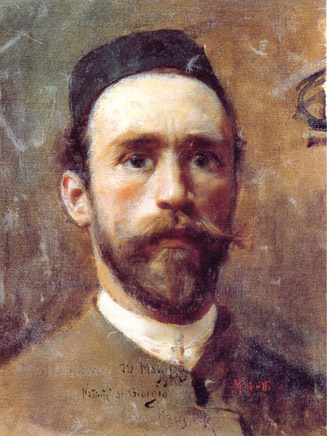 |
Francesco Paolo Michetti was born in Tocco di Casauria on the 4th of October 1851, and his first artistic training took place in Chieti, Abruzzo. His undeniable talent led the city to grant him a scholarship in 1868 to pursue his studies at the Accademia di Belle Arti in Naples. In Naples, Michetti was especially attracted by the realism of Domenico Morelli, Filippo Palizzi and the School of Resina. Despite poor attendance at his academic courses, he nevertheless twice won prizes (Mezza figura di vecchio, 1867-68; Paesaggio con figura, 1868-69). In 1872 Michetti participated at the Paris Salon, and began a collaboration with the German dealer Reutlinger. This would herald a feverish and prolific period full of artistic stimuli. Michetti then met and developed an interest in the work of Mariano Fortuny, and began to study photography, presumably with the mediation of Filippo Palazzi. He exhibited again at the Paris Salon in 1875, and in 1877 attracted critical attention at the Naples National Exhibition, where he presented la Processione del Corpus Domini a Chieti (private collection). Countess La Field, deeply touched by this painting, subsequently commissioned Mattinata, a work which depicts the rehearsal of one of Francesco Paolo Tosti romanza at Francavilla. His participation in important exhibitions became more intense during the late nineteenth century: in 1878 he attended the Universal Exposition in Paris, in 1880 the first International Exhibition of Modern Paintings of the Raffaello Society and the Paris Salon, in 1881 the National Exhibition of Milan. In 1882 he illustrated the Canto Nuovo by Gabriele D’Annunzio which was published by Angelo Sommaruga. The following year marked a turning point in Michetti’s career. The monumental painting Il Voto, presented at the Rome International Exhibition, hits the critics and the public for the raw realism in which it described the feast of Saint Pantaleon at Miglianico. The work, reviewed by D’Annunzio in the pages of “Fanfulla della Domenica”, finally entered Rome's Galleria Nazionale d'Arte Moderna. During the same period Michetti bought the convent of Santa Maria Maggiore in Francavilla, where he invited his friends Costantino Barbella, D'Annunzio, Matilde Serao, Edoardo Scarfoglio and Domenico Tosti during the summer of 1883. The new house became a magnet for artists such as Giulio Aristide Sartorio, Guido Boggiani and Basilio Cascella, who spent long periods painting together. His relationship with D’Annunzio was especially close, who wrote Il piacere (1883-84), L'innocente (1890-92) and part of his Trionfo della morte (1889-94) at Francavilla. In the company of D'Annunzio, Barbella and Antonio De Nino (a scholar of local folklore), the artist visited the most remote locations in Abruzzo, in order to make photographic records of traditional festivals, collecting a wealth of material, which would later be used in the monumental canvases Le Serpi e Gli Storpi (both of which are at the Museo Michetti Francavilla a Mare). The first half of the 1890s saw Michetti participating in major exhibitions in Germany, including the International Art Exhibition of the Society of Artists in Berlin in 1891. In 1895 the painting La Figlia di Jorio (Pescara, Palazzo della Provincia) received a medal at the 1st Venice Biennale. The jury of critics and art historians explained its decision thus: "Michetti [...] has expressed human drama with sincerity, with immense naturalistic power." During the second half of the decade, Michetti's participation in public expositions became ever more sporadic. The artist spent long periods of isolation at the convent of Francavilla, reinterpreting his rich photographic material in carrying out the pictures Le Serpi e Gli Storpi, which would be presented after years in the making at the Paris Universal Exposition of 1900. In this period photography was no longer a simple tool for the gathering of documentary material, but instead became a language of self-expression in its own right, the potential of which was studied in the isolated wilds of Abruzzo. In 1909, Michetti was appointed Senator of the Kingdom, and the following year he agreed to send fifteen of his landscapes to the Venice Biennale. This was to be his last public appearance, and was followed by ultimately futile attempts to persuade him to resubmit his work for public exhibition. However, in 1913 he accepted an invitation to become member of the Ordering Board of the Galleria Nazionale d'Arte Moderna, and also a member in 1921 of the Acquisitions Board of the same institution. He died from pneumonia at the convent of Francavilla on 5th March 1929.
|
  |






